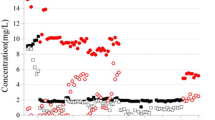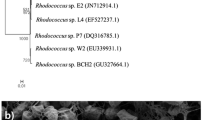Abstract
Perchlorate is a widespread drinking water contaminant with regulatory standards ranging from 2 to 18 μg/L. The hydrogen-based membrane-biofilm reactor (MBfR) can effectively reduce perchlorate, but it is challenging to achieve low-µg/L levels. We explored chlorate addition to increase the abundance of perchlorate-reducing bacteria (PRB) and improve removals. MBfR reactors were operated with and without chlorate addition. Results show that chlorate doubled the abundance of putative PRB (e.g., Rhodocyclales) and improved perchlorate reduction to 23 ± 17 µg/L, compared to 53 ± 37 µg/L in the control. Sulfate reduction was substantially inhibited during chlorate addition, but quickly recovered once suspended. Our results suggest that chlorate addition can enhance perchlorate reduction by providing a selective pressure for PRB. It also decreases net sulfate reduction.
Key points
• Chlorate increased the abundance of perchlorate-reducing bacteria
• Chlorate addition improved perchlorate removal
• Chlorate appeared to suppress sulfate reduction





Similar content being viewed by others
Data availability
The datasets generated during and/or analyzed during the current study are available from the corresponding author on reasonable request.
References
ANSES: French Agency for Food, Environmental and Health Occupational & Safety (2012) ANSES opinion concerning epidemiological studies on associations between exposure to perchlorate in drinking water and thyroid function in specific populations., Vol. 2017. Retrieved 16 May, 2017, from https://www.anses.fr/en/system/files/EAUX2012sa0119EN.pdf
Bardiya N, Bae J-H (2011) Dissimilatory perchlorate reduction: a review. Microbiol Res 166(4):237–254
Bomberg M, Lamminmäki T, Itävaara M (2016) Microbial communities and their predicted metabolic characteristics in deep fracture groundwaters of the crystalline bedrock at Olkiluoto, Finland. Biogeosciences 13(21):6031–6047
CA DEPT (California Department of Public Health) (2007) State adoption of a perchlorate standard. Retrieved 16 May, 2017 from: https://www.waterboards.ca.gov/drinking_water/certlic/drinkingwater/documents/perchlorate/AdoptionMemotoWaterSystems-10-2007.pdf
Caporaso JG, Lauber CL, Walters WA, Berg-Lyons D, Lozupone CA, Turnbaugh PJ, Fierer N, Knight R (2011) Global patterns of 16S rRNA diversity at a depth of millions of sequences per sample. Proc Natl Acad Sci 108(Supplement 1):4516–4522
Carlson HK, Kuehl JV, Hazra AB, Justice NB, Stoeva MK, Sczesnak A, Mullan MR, Iavarone AT, Engelbrektson A, Price MN, Deutschbauer AM, Arkin AP, Coates JD (2015) Mechanisms of direct inhibition of the respiratory sulfate-reduction pathway by (per)chlorate and nitrate. ISME J 9(6):1295–1305
Choe JK, Mehnert MH, Guest JS, Strathmann TJ, Werth CJ (2013) Comparative assessment of the environmental sustainability of existing and emerging perchlorate treatment technologies for drinking water. Environ Sci Technol 47(9):4644–4652
Coates JD, Achenbach LA (2004) Microbial perchlorate reduction: rocket-fuelled metabolism. Nat Rev Microbiol 2(7):569–580
Coates JD, Chakraborty R, Lack JG, O’Connor SM, Cole KA, Bender KS, Achenbach LA (2001) Anaerobic benzene oxidation coupled to nitrate reduction in pure culture by two strains of Dechloromonas. Nature 411:1039
Coates JD, Michaelidou U, Bruce RA, O’Connor SM, Crespi JN, Achenbach LA (1999) Ubiquity and diversity of dissimilatory (per)chlorate-reducing bacteria. Appl Environ Microbiol 65(12):5234–5241. https://doi.org/10.1128/AEM.65.12.5234-5241
Dasgupta PK, Martinelango PK, Jackson WA, Anderson TA, Tian K, Tock RW, Rajagopalan S (2005) The origin of naturally occurring perchlorate: the role of atmospheric processes. Environ Sci Technol 39(6):1569–1575. https://doi.org/10.1021/es048612x
DeSantis TZ, Hugenholtz P, Larsen N, Rojas M, Brodie EL, Keller K, Huber T, Dalevi D, Hu P, Andersen GL (2006) Greengenes, a Chimera-checked 16S rRNA gene database and workbench compatible with ARB. Appl Environ Microbiol 72(7):5069–5072
EFSA Panel on Contaminants in the Food Chain (EFSA CONTAM Panel) (2014) Scientific opinion on the risks to public health related to the presence of perchlorate in food, in particular fruits and vegetables. EFSA J 12(10):3869
Engelbrektson A, Hubbard CG, Tom LM, Boussina A, ** YT, Wong H, Piceno YM, Carlson HK, Conrad ME, Anderson G, Coates JD (2014) Inhibition of microbial sulfate reduction in a flow-through column system by (per)chlorate treatment. Front Microbiol 5:315
Engelbrektson AL, Cheng Y, Hubbard CG, ** YT, Arora B, Tom LM, Hu P, Grauel A-L, Conrad ME, Andersen GL, Ajo-Franklin JB, Coates JD (2018) Attenuating sulfidogenesis in a soured continuous flow column system with perchlorate treatment. Front Microbiol 9:1575–1575
Kersters K, De Vos P, Gillis M, Swings J, Vandamme P, Stackebrandt E (2006) Introduction to the proteobacteria. In: Dworkin M, Falkow S, Rosenberg E, Schleifer K-H, Stackebrandt E (eds) The prokaryotes: Volume 5: Proteobacteria: alpha and beta subclasses. Springer, New York, pp 3–37
Kraft B, Tegetmeyer HE, Meier D, Geelhoed JS, Strous M (2014) Rapid succession of uncultured marine bacterial and archaeal populations in a denitrifying continuous culture. Environ Microbiol 16(10):3275–3286
Li R, Tun HM, Jahan M, Zhang Z, Kumar A, Dilantha Fernando WG, Farenhorst A, Khafipour E (2017) Comparison of DNA-, PMA-, and RNA-based 16S rRNA Illumina sequencing for detection of live bacteria in water. Sci Rep 7(1):5752
Liu W, Lian J, Guo J, Zhang C, Guo Y, Niu Y, Duan L (2019) Perchlorate reduction by anaerobic granular sludge under different operation strategies: performance, extracellular polymeric substances and microbial community. Bioresour Technol Rep 8:100312. https://doi.org/10.1016/j.biteb.2019.100312
Ma H, Bonnie NA, Yu M, Che S, Wang Q (2016) Biological treatment of ammonium perchlorate-contaminated wastewater: a review. J Water Reuse Desalination 7(4):82–107
MA DEPT. (Massachussets Department of Environmental Protection) (2006) Update to “Perchlorate Toxicological Profile and Health Assessment”. Available: https://www.mass.gov/doc/310-cmr-2200-the-massachusetts-drinking-water-regulations/download
Martin KJ, Nerenberg R (2012) The membrane biofilm reactor (MBfR) for water and wastewater treatment: principles, applications, and recent developments. Bioresour Technol 122:83–94
Martin KJ, Picioreanu C, Nerenberg R (2015) Assessing microbial competition in a hydrogenbased membrane biofilm reactor (MBfR) using multidimensional modeling. Biotechnol Bioeng 112(9):1843–1853. https://doi.org/10.1002/bit.25607
Muyzer G, Stams AJM (2008) The ecology and biotechnology of sulphate-reducing bacteria. Nat Rev Microbiol 6:441
Nerenberg R, Kawagoshi Y, Rittmann BE (2006) Kinetics of a hydrogen-oxidizing, perchlorate-reducing bacterium. Water Res 40(17):3290–3296
Nerenberg R, Kawagoshi Y, Rittmann BE (2008) Microbial ecology of a perchlorate-reducing, hydrogen-based membrane biofilm reactor. Water Res 42(4–5):1151–1159
Ontiveros-Valencia A, Tang Y, Krajmalnik-Brown R, Rittmann BE (2013) Perchlorate reduction from a highly contaminated groundwater in the presence of sulfate-reducing bacteria in a hydrogen-fed biofilm. Biotechnol Bioeng 110(12):3139–3147
Ontiveros-Valencia A, Tang Y, Krajmalnik-Brown R, Rittmann BE (2014a) Managing the interactions between sulfate- and perchlorate-reducing bacteria when using hydrogen-fed biofilms to treat a groundwater with a high perchlorate concentration. Water Res 55:215–224
Ontiveros-Valencia A, Tang Y, Zhao H-P, Friese D, Overstreet R, Smith J, Evans P, Rittmann BE, Krajmalnik-Brown R (2014b) Pyrosequencing analysis yields comprehensive assessment of microbial communities in pilot-scale two-stage membrane biofilm reactors. Environ Sci Technol 48(13):7511–7518
Oren A (2014) The Family Xanthobacteraceae. In: Rosenberg E, DeLong EF, Lory S, Stackebrandt E, Thompson F (eds) The Prokaryotes: Alphaproteobacteria and Betaproteobacteria. Springer, Berlin Heidelberg, pp 709–726
Roldán MD, Reyes F, Moreno-Vivián C, Castillo F (1994) Chlorate and nitrate reduction in the phototrophic bacteria Rhodobacter capsulatus and Rhodobacter sphaeroides. Curr Microbiol 29(4):241–245
Shao M-F, Zhang T, Fang H (2010) Sulfur-driven autotrophic denitrification: diversity, biochemistry, and engineering applications. Appl Microbiol Biotechnol 88:1027–1042
Sijimol MR, Jyothy S, Pradeepkumar AP, Chandran MSS, Ghouse SS, Mohan M (2015) Review on Fate, Toxicity, and Remediation of Perchlorate. Environ Forensics 16(2):125–134
Srinivasan R, Sorial GA (2009) Treatment of perchlorate in drinking water: a critical review. Sep Purif Technol 69(1):7–21
Steinberg LM, Trimble JJ, Logan BE (2005) Enzymes responsible for chlorate reduction by Pseudomonas sp. Are different from those used for perchlorate reduction by Azospira sp. FEMS Microbiol Lett 247(2):153–159. https://doi.org/10.1016/j.femsle.2005.05.003
Tang Y, Zhao H, Marcus AK, Krajmalnik-Brown R, Rittmann BE (2012) A Steady-State Biofilm Model for Simultaneous Reduction of Nitrate and Perchlorate, Part 2: Parameter Optimization and Results and Discussion. Environ Sci Technol 46(3):1608–1615
Tang Y, Ontiveros-Valencia A, Feng L, Zhou C, Krajmalnik-Brown R, Rittmann BE (2013) A biofilm model to understand the onset of sulfate reduction in denitrifying membrane biofilm reactors. Biotechnol Bioeng 110(3):763–772
US Environmental Protection Agency (US EPA) (2009) Revised Assessment Guidance for Pechlorate. Memorandum to Regional Administrators. US EPA Office of Solid Waste and Emergency Response, Washington, DC
Willems A (2014) The Family Comamonadaceae. In: Rosenberg E, DeLong EF, Lory S, Stackebrandt E, Thompson F (eds) The prokaryotes: Alphaproteobacteria and Betaproteobacteria. Springer, Berlin Heidelberg, pp 777–851
Willems A., Gillis, M. 2015. Hydrogenophaga. in: Bergey’s manual of systematics of archaea and bacteria, (Ed.) W. B. Whitman, F. Rainey, P. Kämpfer, M. Trujillo, J. Chun, P. DeVos, B. Hedlund and S. Dedysh.
World Health Organization (WHO) (2004) Sulfate in drinking-water. WHO Press
World Health Organization (WHO) (2011) Nitrate and nitrite in drinking-water. WHO Press
World Health Organization (WHO) (2016) Chlorine dioxide, chlorite and chlorate in drinking-water. WHO Press
Yang B, Wang Y, Qian P-Y (2016) Sensitivity and correlation of hypervariable regions in 16S rRNA genes in phylogenetic analysis. BMC Bioinformatics 17(1):135. https://doi.org/10.1186/s12859-016-0992-y
Ye L, You H, Yao J, Su H (2012) Water treatment technologies for perchlorate: a review. Desalination 298:1–12
Youngblut MD, Wang O, Barnum TP, Coates JD (2016) (Per)chlorate in biology on Earth and beyond. Annu Rev Microbiol 70:435–457
Zhang S, Pang S, Wang P, Wang C, Guo C, Addo FG, Li Y (2016) Responses of bacterial community structure and denitrifying bacteria in biofilm to submerged macrophytes and nitrate. Sci Rep 6:36178
Zhang M, Li X, Cheng X, Wang X, Song M, Wang X, Ma X (2021) Isotopic tracing of perchlorate sources in the environment. J Chem 2021:9978489. https://doi.org/10.1155/2021/9978489
Zhao HP, Van Ginkel S, Tang Y, Kang DW, Rittmann B, Krajmalnik-Brown R (2011) Interactions between perchlorate and nitrate reductions in the biofilm of a hydrogen-based membrane biofilm reactor. Environ Sci Technol 45(23):10155–10162
Acknowledgements
The authors gratefully acknowledge the Center for Environmental Science and Technology (CEST) at Notre Dame for their support with analytical equipment.
Funding
This research was supported by the University of Notre Dame-Pontificia Universidad Católica Collaborative Seed Fund, the CEDEUS (Centro de Desarrollo Urbano Sustentable) CONICYT/FONDAP/15110020, FONDECYT 1201134, and National Scholarship for PhD (CONICYT, Chile) 21161573.
Author information
Authors and Affiliations
Contributions
RN, ITV, and MV conceived and designed the research. MV and AOV conducted the experiments and analyzed the data. MV wrote the manuscript. RN, AOV, and ITV revised the manuscript. All authors read and approved the manuscript.
Corresponding author
Ethics declarations
Ethics approval
This article does not contain any studies with human participants or animals performed by any of the authors.
Conflict of interest
The authors declare no competing interests.
Additional information
Publisher's note
Springer Nature remains neutral with regard to jurisdictional claims in published maps and institutional affiliations.
Supplementary Information
Below is the link to the electronic supplementary material.
Rights and permissions
About this article
Cite this article
Vega, M., Ontiveros-Valencia, A., Vargas, I.T. et al. Chlorate addition enhances perchlorate reduction in denitrifying membrane-biofilm reactors. Appl Microbiol Biotechnol 106, 4341–4350 (2022). https://doi.org/10.1007/s00253-022-11976-1
Received:
Revised:
Accepted:
Published:
Issue Date:
DOI: https://doi.org/10.1007/s00253-022-11976-1




